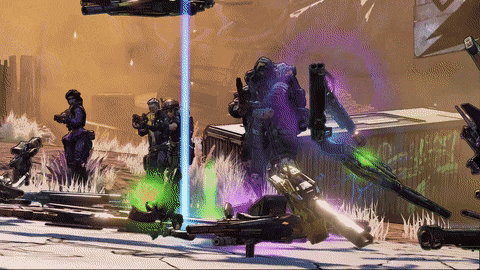In 10 short years, Gearbox Software’s post-apocalyptic Borderlands series has become one of the best-selling video game franchises of all time. Since it debuted in 2009, players have fallen in love with its comedic and cooperative take on the FPS genre, its comic book art style, and its truly obscene weapon variety, numbering in the millions. The brand new Borderlands 3 managed to ratchet that weapon count up even higher, into the billions, and it brought sales along with it, setting a new record for the series by selling over 5 million copies in five days.
“I don’t really know if I’ve processed it yet,” says Gearbox Software level designer and 2016 BA in Game Design graduate Stephan Haldaman. “I knew millions of people would be experiencing the work I was doing, but now when I’m not at work, I’m hyperaware every time I see a Borderlands reference. It’s a daily thing now and still catches me off guard.”

If you’re one of the millions of people who have picked up Borderlands 3 and tried out its billions of randomized weapons, you’ve almost certainly played through areas, battles, and missions Haldaman helped craft, script, and refine. Some levels, like main story area the Pyre of Stars, Haldaman blocked out from scratch. “That was quite a long process,” Haldaman says. “I worked with a mission designer to figure out the combat and story pacing of the level, but it really came together once a level artist did a full art pass over my layout.”
Haldaman also had a heavy hand in designing and creating the game’s new Proving Grounds gauntlets, which throw players into arenas and charge them with defeating hordes of enemies and a final boss in 30 minutes or less. “I prototyped different implementations of how the Proving Grounds could work,” Haldaman says. “The Proving Grounds were a new concept to Borderlands and we spent a lot of time figuring out what they should be. It went through a lot of iterations and testing before it became what it is today.”

Haldaman also worked extensively on one of the series’ returning challenges, the Circle of Slaughter arenas, which pit players against waves of enemies over five rounds. “There’s a lot of meticulous detail that went into that game mode because of how many enemies show up in such a small space!” Haldaman says.
Even outside those densely packed arenas, Haldaman had to carefully consider the spatial qualities of Borderlands’ levels and how they might work given the many potential variables in any given play session. Beyond the billions of possible weapons combinations, the game’s co-op mode also allows players to pick from four separate characters with unique skill trees, giving Haldaman a lot to think about.
“It’s quite difficult to design levels around four characters with incredibly varied abilities, and we always had to be thinking about how our level layouts will be played between one to four players and a number of enemies that can scale based on the number of players,” Haldaman says. “We always built combat around a minimum and maximum amount of space, based on things like general weapon distances and how many players could comfortably fit in an area together.”
In some situations, finding that balance became even trickier. For instance, if four players all choose to play as FL4K, a robot that always has a pet companion fighting alongside them, not only do you have the maximum number of enemies spawning, you also effectively have eight player characters instead of just four. Things get cramped fast.
“But at the same time,” Haldaman says, “you never want a space to be too big and have too much walking. It was a project-long challenge to balance those two factors.”

For the first time in the series, Borderlands 3 allows players to explore off-world locations far beyond the desolate planet of Pandora from the first two games. While the opportunity to design totally new locations for players to explore was exciting, Haldaman says it also came with its own set of challenges as well. “Some of the visual and structural things I was working on had nothing to reference from Borderlands 1 or 2,” Haldaman says. “I worked with concept and level artists to help figure out just how levels should be built using some of the alien art sets that were created, and it went through a lot of iterations before we wound up with what you see in the game, both in the assets themselves and how we used them to create the levels.”
Solving all the unique level design challenges presented by Borderlands 3 required a lot of interdisciplinary collaboration from the Gearbox team. According to Haldaman, one of the most important takeaways from his DigiPen experience was learning how to thrive in just that type of creative, problem-solving environment. “The most memorable experience I had was working with a big team, about 22 people total, on Relic, a sci-fi third-person platformer,” Haldaman says of the student project that helped him discover his love for level design. “The most valuable things I learned at DigiPen were my specific strengths and weaknesses when working in groups and what I needed to improve. DigiPen was a great place to make my mistakes and learn what I really wanted to do in a full-time game design job.”
